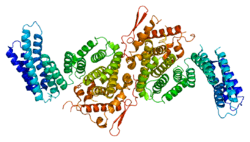SMG7
Protein SMG7 is a protein that in humans is encoded by the SMG7 gene.[3][4][5]
References
- ↑ "Human PubMed Reference:".
- ↑ "Mouse PubMed Reference:".
- ↑ Ohnishi T, Yamashita A, Kashima I, Schell T, Anders KR, Grimson A, Hachiya T, Hentze MW, Anderson P, Ohno S (Nov 2003). "Phosphorylation of hUPF1 induces formation of mRNA surveillance complexes containing hSMG-5 and hSMG-7". Mol Cell. 12 (5): 1187–200. doi:10.1016/S1097-2765(03)00443-X. PMID 14636577.
- ↑ Fukuhara N, Ebert J, Unterholzner L, Lindner D, Izaurralde E, Conti E (Feb 2005). "SMG7 is a 14-3-3-like adaptor in the nonsense-mediated mRNA decay pathway". Mol Cell. 17 (4): 537–47. doi:10.1016/j.molcel.2005.01.010. PMID 15721257.
- ↑ "Entrez Gene: SMG7 Smg-7 homolog, nonsense mediated mRNA decay factor (C. elegans)".
Further reading
- Nakajima D, Okazaki N, Yamakawa H, et al. (2003). "Construction of expression-ready cDNA clones for KIAA genes: manual curation of 330 KIAA cDNA clones.". DNA Res. 9 (3): 99–106. doi:10.1093/dnares/9.3.99. PMID 12168954.
- Nagase T, Seki N, Ishikawa K, et al. (1997). "Prediction of the coding sequences of unidentified human genes. VI. The coding sequences of 80 new genes (KIAA0201-KIAA0280) deduced by analysis of cDNA clones from cell line KG-1 and brain.". DNA Res. 3 (5): 321–9, 341–54. doi:10.1093/dnares/3.5.321. PMID 9039502.
- Sood R, Bonner TI, Makalowska I, et al. (2001). "Cloning and characterization of 13 novel transcripts and the human RGS8 gene from the 1q25 region encompassing the hereditary prostate cancer (HPC1) locus.". Genomics. 73 (2): 211–22. doi:10.1006/geno.2001.6500. PMID 11318611.
- Strausberg RL, Feingold EA, Grouse LH, et al. (2003). "Generation and initial analysis of more than 15,000 full-length human and mouse cDNA sequences". Proc. Natl. Acad. Sci. U.S.A. 99 (26): 16899–903. doi:10.1073/pnas.242603899. PMC 139241
 . PMID 12477932.
. PMID 12477932.
- Reichenbach P, Höss M, Azzalin CM, et al. (2003). "A human homolog of yeast Est1 associates with telomerase and uncaps chromosome ends when overexpressed". Curr. Biol. 13 (7): 568–74. doi:10.1016/S0960-9822(03)00173-8. PMID 12676087.
- Snow BE, Erdmann N, Cruickshank J, et al. (2004). "Functional conservation of the telomerase protein Est1p in humans". Curr. Biol. 13 (8): 698–704. doi:10.1016/S0960-9822(03)00210-0. PMID 12699629.
- Ota T, Suzuki Y, Nishikawa T, et al. (2004). "Complete sequencing and characterization of 21,243 full-length human cDNAs". Nat. Genet. 36 (1): 40–5. doi:10.1038/ng1285. PMID 14702039.
- Gerhard DS, Wagner L, Feingold EA, et al. (2004). "The Status, Quality, and Expansion of the NIH Full-Length cDNA Project: The Mammalian Gene Collection (MGC)". Genome Res. 14 (10B): 2121–7. doi:10.1101/gr.2596504. PMC 528928
 . PMID 15489334.
. PMID 15489334.
- Unterholzner L, Izaurralde E (2005). "SMG7 acts as a molecular link between mRNA surveillance and mRNA decay". Mol. Cell. 16 (4): 587–96. doi:10.1016/j.molcel.2004.10.013. PMID 15546618.
- Azzalin CM, Lingner J (2006). "The human RNA surveillance factor UPF1 is required for S phase progression and genome stability". Curr. Biol. 16 (4): 433–9. doi:10.1016/j.cub.2006.01.018. PMID 16488880.
- Gregory SG, Barlow KF, McLay KE, et al. (2006). "The DNA sequence and biological annotation of human chromosome 1". Nature. 441 (7091): 315–21. doi:10.1038/nature04727. PMID 16710414.
- Olsen JV, Blagoev B, Gnad F, et al. (2006). "Global, in vivo, and site-specific phosphorylation dynamics in signaling networks". Cell. 127 (3): 635–48. doi:10.1016/j.cell.2006.09.026. PMID 17081983.
PDB gallery |
|---|
|
| 1ya0: Crystal structure of the N-terminal domain of human SMG7 |
|
|




 . PMID 12477932.
. PMID 12477932. . PMID 15489334.
. PMID 15489334.